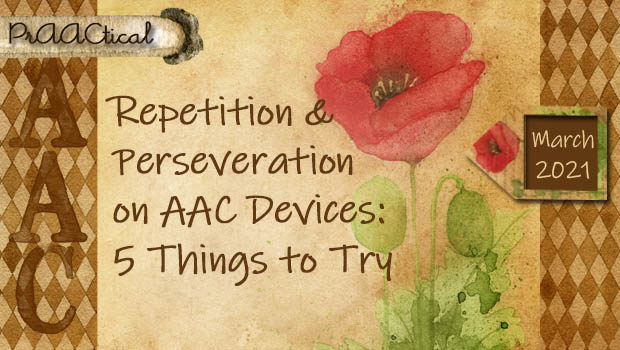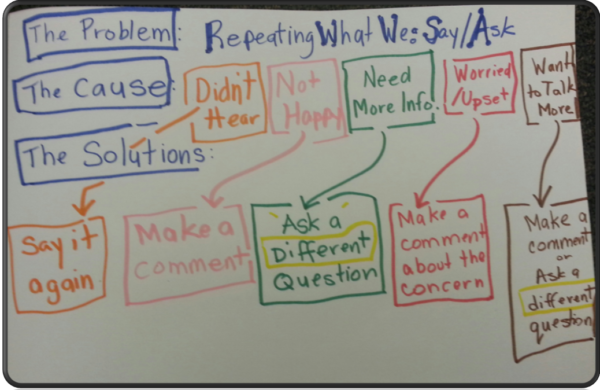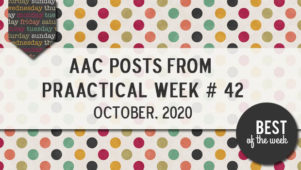Repetition & Perseveration on AAC Devices: 5 Things to Try

It’s not unusual for people who are learning to use AAC to repeat themselves, something we’ve written about before. While it’s not usually a problem, there are times when this is less than desirable. Here are a few things to think about as you determine how to proceed.
- Look for the meaning. There’s almost always a reason why people repeat things in their AAC systems. We have to do some sleuthing to figure it out, but it’s worth the effort. One memorable example of this was from Candace, who kept navigating away from what I had planned for us to talk about and repeating things about camp. Initially, I didn’t think much of it, but when she persisted, I did some digging and eventually found out that something pretty scary happened to her there. Those repetitions were probably the best way she could think of to engage me in a topic that she needed to talk about in order to process what happened and deal with troubling memories. Repetition can mean many things, such as normal curiosity and exploration, signaling boredom or anxiety, or redirection to a topic they need help with. Guess what? When I’m really nervous, I sometimes fall back on scripted language and repetition while I gather my thoughts, and maybe you do, too.
- Plan time during the day for experimentation. For some AAC users, it can be helpful to set aside some time to explore and experiment with their device, so we might put that into the schedule a few times during the day. The times that I’ve done that with clients, we found that a few very short bursts of this can be very beneficial in lessening the desire to repeat words and phrases.
- Need time to talk with a parent, aide, or caregiver? Maybe your client/student can have some time exploring their device and saying whatever they want while you engage with their communication partner (if you’re lucky enough to have them in the session). We can build this into our therapy at the beginning or end so that we have time to talk with the caregiver for a few minutes. In most instances when I’ve used this approach, it was a win-win situation: The students happily repeated things they wanted to say without anyone redirecting them and I had a few minutes to explain this or that to the aide or parent.
- Look for patterns. Of course, it is also helpful to try to determine what the student is actually doing when they explore. Once in a while, I see a theme to what words they are using or where they are going w/in the device. If it seems like there is a pattern (e.g., animals, foods, people) I try to build that into our work together for part of the session. So if the student starts listing foods, I’ll make a list of 3-4 of the ones that were named and build an activity using those words.
- Teach a new skill. Sometimes, people repeat themselves because they want to engage on a topic but can’t quite think of what else to say or how to say it. This sometimes happens with questions. It can be very annoying to caregivers or other communication partners to have someone ask the same thing over and over, so therapists get asked to address it. One option is to teach the learner how to think about the situation and do some problem-solving. Lily struggled with repeating questions to her parents, teachers and friends. It was bothersome to people she loved, but, more importantly, it was problematic because the end result was not what Lily really wanted or needed. In the image below, a hastily created visual support helped us think about this by asking key questions:
- Is repeating myself a problem in this situation? (Yes, if it means the learner is not really getting their needs met.)
- Why do I want to repeat myself? What’s causing me to want to ask that question again?
- Is there a different way to solve the problem?

Together, we came up with the various things that caused Lily to want to repeat her question, and then we brainstormed some solutions. The resulting visual support illustrates the solution strategies that we can up with for each situation. Over the course of a few therapy sessions, we practiced using these strategies and eventually, Lily no longer needed the visual support. After a while, Lily was able to use the strategies independently when she caught herself repeating a question.
Have you found strategies that are helpful to AAC learners who repeat themselves? We’d love to hear about them.
Filed under: Featured Posts, PrAACtical Thinking
Tagged With: language therapy
This post was written by Carole Zangari





3 Comments
Repetition of words on AAC can also be like echolalia. It is a good thing. It should not be stopped.
First, does it hurt anyone?
Second, if it is calming, fun, joyful or a way of communication why stop it?
Third, we encourage speaking children to play with words all the time. We get them to rhyme, use literary devices, jokes and idioms. When a neurodiverse person plays with words differently, why do we stop them or try to figure out what to do about it.
Lastly, repeating words or phrases is a very good way to learn where they are and remember them.
Naomi, thanks for these great comments. I wasn’t specifically thinking about echolalia but it certainly does have relevance here. Each of these situations is so different that we absolutely need to be thoughtful in determining whether &/or how to address them. Sometimes, of course, no intervention is needed at all save perhaps some training for communication partners so that they respond in supportive ways. Other times, I think that intervention can be helpful. In Lily’s situation, for example, she was very frustrated b/c repeating the same question wasn’t getting her what she wanted out of the interaction. Often, she needed more information or just someone who would talk with her about the situation so that she could vent, process, share, challenge, problem-solve, etc. Talking things through was very important for Lily and she sought out those sorts of interactions. The best way she knew to initiate those talks was by repeating the same question (which got her the same answers). That usually left her less than satisfied and she often found it very frustrating. Lily was a strong device user who could find anything in her SGD (or spell it) but wanted help using language more effectively to meet her needs. Once she learned more options, she could then choose whether to repeat the same question or take a different approach.
It’s good that you figured out the purpose of the repetitive speech. Often it’s just assumed though that it serves no function for the user and thus the user is automatically stopped from repeaing things to make them “do it right.” In university I totally annoyed my dorm mates by singing the same song over and over to them, it I realize now that I no longer feel that I have to be “normal” as I was forced to be from a very young age, was my way of saying something very specific to them. It probably seemed childlike to them but it served as a way of communication for me. I am a fairly new part-time AAC user who now advocates against stopping stimming that serves very important functions in the lives of neurodiverse people.